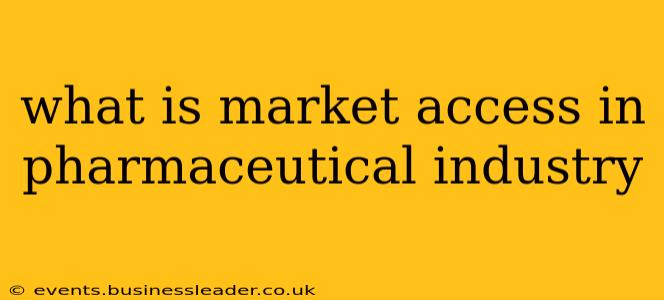Market access in the pharmaceutical industry refers to the complex process of ensuring that patients can obtain and afford the medications they need. It's much more than simply getting a drug approved by regulatory bodies like the FDA; it encompasses a broad range of strategies and activities aimed at making a drug available to the intended patient population. This involves navigating intricate healthcare systems, reimbursement processes, and payer perspectives to secure appropriate pricing and formulary placement. Ultimately, market access is crucial for the successful launch and commercialization of any pharmaceutical product.
What are the key challenges in achieving market access?
Gaining market access presents numerous hurdles for pharmaceutical companies. These challenges often intertwine and necessitate a multi-faceted approach. Some key difficulties include:
-
High Drug Prices and Reimbursement Hurdles: The cost of developing and manufacturing innovative pharmaceuticals is substantial, often leading to high prices that may be unaffordable for many patients or payers (insurance companies, government programs). Negotiating favorable reimbursement rates with payers is a significant challenge, particularly for newer, more expensive drugs.
-
Regulatory Approval and Compliance: Securing regulatory approval from agencies like the FDA (in the US) is just the first step. Companies must then comply with ongoing post-market surveillance and reporting requirements, which can significantly impact market access.
-
Payer Formularies and Prior Authorizations: Many payers have formularies – lists of approved drugs – that dictate which medications they will cover. Getting a drug onto a formulary often involves demonstrating its clinical value and cost-effectiveness compared to existing treatments. Even with formulary inclusion, patients may face prior authorization requirements, adding another layer of complexity to access.
-
Evidence Generation and Value Demonstration: Payers increasingly demand robust clinical evidence to justify the cost of new drugs. This necessitates well-designed clinical trials, real-world evidence studies, and economic modeling to demonstrate the cost-effectiveness and overall value proposition of the medication.
-
Competition and Differentiation: The pharmaceutical market is highly competitive. To gain market access, companies must differentiate their products from existing treatments, highlighting unique features, benefits, and patient populations served.
-
Patient Access Programs and Support: Beyond pricing and reimbursement, many companies offer patient access programs to help patients afford and manage their medications. These programs can include co-pay assistance, financial aid, and medication adherence support.
What strategies are used to improve market access?
Pharmaceutical companies employ various strategies to enhance market access for their products. These include:
-
Pricing and Reimbursement Strategies: Negotiating favorable prices with payers and developing creative reimbursement models (e.g., outcome-based pricing, value-based agreements) are critical.
-
Clinical Development and Evidence Generation: Designing clinical trials that specifically address payer priorities and conducting post-market studies to demonstrate long-term value and safety.
-
Health Economics and Outcomes Research (HEOR): Conducting HEOR studies to quantify the cost-effectiveness and clinical benefits of a drug, showcasing its value proposition to payers.
-
Market Access Teams and Expertise: Assembling dedicated market access teams with expertise in payer relations, reimbursement processes, health economics, and regulatory affairs.
-
Government Affairs and Advocacy: Engaging with government agencies and advocacy groups to influence policy decisions related to drug pricing, reimbursement, and patient access.
-
Patient Advocacy and Engagement: Working with patient advocacy groups to raise awareness of the disease and the benefits of the medication, fostering patient demand.
How is market access different in various countries?
Market access strategies vary significantly across countries due to differences in healthcare systems, regulatory frameworks, and payer landscapes. The US system, for instance, is characterized by a complex interplay of private and public payers, while other countries may have more centralized healthcare systems with greater government control over drug pricing and reimbursement. Understanding these nuances is crucial for successful market access in different regions.
What are the future trends in pharmaceutical market access?
The future of pharmaceutical market access will likely be shaped by several key trends:
-
Increased focus on value-based healthcare: Payers are increasingly shifting away from fee-for-service models towards value-based care, emphasizing the clinical and economic outcomes of treatments.
-
Growing use of real-world evidence (RWE): RWE is becoming increasingly important for demonstrating the long-term benefits and cost-effectiveness of drugs in real-world settings.
-
Advancements in digital health and technology: Digital tools and technologies are being used to improve patient access, track medication adherence, and generate RWE.
-
Greater transparency and data sharing: Increased transparency and data sharing across the healthcare ecosystem can improve decision-making and enhance market access.
Market access is a dynamic and multifaceted field, constantly evolving in response to changes in healthcare systems, regulatory landscapes, and payer priorities. Successful navigation of this landscape is essential for the successful launch and commercialization of any pharmaceutical product.
